Helium, Hydrogen, or Nitrogen—The Choice is Yours: Unique Rtx-CLPesticides Column Set Provides Optimal Results for Organochlorine Pesticides GC-Micro-ECD Analysis Using Any Carrier Gas
The Rtx-CLPesticides Column Set Lets You Make the Choice
• Option 1: Get faster results from helium than when using competitor columns
• Option 2: Save money and increase sample throughput using hydrogen
• Option 3: Simplify the gas system and reduce costs using nitrogen
Over the past few years, the increasing costs and uncertain availability of helium have prompted many labs to explore alternate carrier gas options. While switching from helium to either hydrogen or nitrogen carrier gas can be problematic for methods using a mass spectrometer, methods that employ an electron capture detector (ECD) are generally good candidates for transfer as long as column selectivity is adequate. For heavily used methods that employ helium, such as organochlorine pesticides analysis following EPA Method 8081, conversion to a different carrier gas provides a significant cost savings opportunity. Here we compared the performance of Rtx-CLPesticides and Rtx-CLPesticides2 columns to a competitor's CLP column set using helium, hydrogen, and nitrogen carrier gases for this frequently used dual-column GC-ECD method. These column sets differ in selectivity, and since proprietary Rtx-CLPesticides and Rtx-CLPesticides2 columns were developed specifically for organochlorine pesticides analysis by GC-ECD, their unique column selectivities provide optimal resolution and fast analysis times whether operated using helium, hydrogen, or nitrogen carrier gases. In addition, since the Rtx-CLPesticides columns provide more separation between critical peaks compared to competitor columns, they can be trimmed for maintenance without sacrificing resolution, which results in longer column lifetimes. This extra separating power also gives you more room for method optimization, so you can save time on every analysis.
Both hydrogen and nitrogen are less expensive than helium and can be reliably supplied commercially or using in-lab generators. Either carrier gas option provides significant cost savings compared to helium, but it is important to consider the relative pros and cons of each gas prior to switching to an alternate carrier gas. Since hydrogen has a higher optimal linear velocity and can be operated at higher flow rates, analytes elute earlier than when using helium, which allows faster analysis times and increased sample throughput. However, as discussed later, hydrogen is a flammable reducing gas that must be used with some basic precautions in order to avoid safety issues and problems with poor response due to active sites in the system. In contrast, nitrogen is highly inert and also can be used as a replacement for helium. Although it has the advantage of inertness, nitrogen must be used at slower flow rates in order to obtain adequate resolution between peaks, significantly increasing analysis times. Since nitrogen is also generally used as the ECD make-up gas, using it as the carrier gas allows for a simple single-gas setup that is extremely cost-effective. Regardless of which carrier gas is used, columns with optimized selectivity are advantageous because they provide enough separation between critical pairs to allow instrument conditions to be optimized for faster analysis.
In order to evaluate the relative performance of both column sets using all three carrier gases, we used an Agilent 6890 GC with a split/splitless inlet and dual micro-ECDs. The dual column configuration for each column pair was set up using a 5 m x 0.32 mm Rxi guard column (cat.# 10039) connected to the analytical columns using a universal “Y” Press-Tight connector (cat.# 20406). Comparisons of the Rtx-CLPesticides and the competitor column sets were made using a single ramp oven temperature program. The temperature program was not changed, but the flow rate was adjusted for each column set and gas combination in order to obtain the fastest analysis time possible under the standardized oven conditions. For each combination, flow was increased until acceptable resolution could no longer be obtained. In addition to the competitor comparison, a faster method using an accelerated oven temperature program was also evaluated for the Rtx-CLPesticides column set using both helium and hydrogen. Results are summarized in Table I, while chromatograms and the benefits and limitations of each carrier gas are presented in subsequent sections discussing considerations of the three carrier gas options. Calibrations were also evaluated using a 6-point curve (1–100 ppb) and results are presented in Table II.
Regardless of the carrier gas you choose, the success of your analysis depends in large part on which analytical columns are used. Whether you stick with helium or explore using other carrier gases, Restek’s Rtx-CLPesticides column set outperforms competitor columns and provides optimal resolution and fast run times.
Table I: Rtx-CLPesticides and Rtx-CLPesticides2 columns were developed specifically for organochlorine pesticides analysis by GC-ECD, and their unique column selectivities give you the speed and resolution you need, so you can pick the carrier gas you want. See Figures 1-9 for chromatographic results and conditions.
| Elution Time of Last Eluting Compound (min) | |||||
|---|---|---|---|---|---|
| Helium | Hydrogen | Nitrogen | Helium (Fast Method) |
Hydrogen (Fast Method) |
|
| Rtx-CLPesticides column set | 9.44 | 9.36 | 9.37 | 6.95 | 6.75 |
| Competitor column set | 10.18 | 10.12 | Inadequate resolution |
* | * |
| * The purpose of this study was to compare columns of differing selectivity under typical operating conditions. The accelerated method was optimized for the Rtx -CLPesticides column set and is not transferable to the competitor column set because these column sets do not have the same selectivity. | |||||
Table II: Rtx-CLPesticides columns provided calibrations that met the Method 8081 requirement of <20% relative standard deviation (RSD) for each individual compound (averages shown below).
| Average %RSD for all Analytes* | |||
|---|---|---|---|
| Helium | Hydrogen | Nitrogen | |
| Rtx-CLPesticides | 4.4 | 4.5 | 4.1 |
| Rtx-CLPesticides2 | 5.2 | 7.6 | 4.0 |
| *%RSD was calculated first for each analyte using six standards across the calibration range (1–100 ppb), then average %RSD across all analytes was calculated. | |||
Option 1: Get Faster Results From Helium Than When Using Competitor Columns
Helium is still the most commonly used carrier gas for GC. Despite cost and availability concerns, helium continues to be the workhorse carrier gas because it provides excellent separations in a reasonable analysis time. Since the Rtx-CLPesticides columns were developed by Restek to have unique selectivities specifically for organochlorine pesticides, they provide excellent resolution of these target compounds. Using the single ramp oven program, all analytes were completely separated in 9.44 min using a helium carrier gas flow rate of 3.5 mL/min (Figure 1). Note that this flow rate is higher than the maximum optimal flow rate for helium, but since Restek’s highly selective Rtx-CLPesticides column set provides more-than-adequate separation under optimum conditions, they can be reliably optimized for maximum time savings. In comparison, this flow rate was not adequate to resolve all compounds on the competitor column set, so the flow was adjusted until acceptable resolution could be obtained. Using a helium carrier gas flow of 4.8 mL/min, adequate resolution was obtained for all analytes, although the high degree of retention for decachlorobiphenyl resulted in this last compound not eluting until 10.18 min (Figure 2). When using helium carrier gas, the Rtx-CLPesticides column set provides a significant advantage over the competitor's column pair in that similar separations were obtained while saving over half a minute per analysis.
Figure 1: The Rtx-CLPesticides column set separates organochlorine pesticides in just 9.44 min using helium, compared to 10.18 min with the competitor's CLP column set.

| Peaks | Conc. (ng/mL) | |
|---|---|---|
| 1. | Tetrachloro-m-xylene | 20 |
| 2. | Hexachlorobenzene | 5 |
| 3. | α-BHC | 5 |
| 4. | γ-BHC | 5 |
| 5. | β-BHC | 5 |
| 6. | δ-BHC | 5 |
| 7. | Heptachlor | 5 |
| 8. | Aldrin | 5 |
| 9. | Heptachlor epoxide | 5 |
| 10. | trans-Chlordane | 5 |
| 11. | cis-Chlordane | 5 |
| Peaks | Conc. (ng/mL) | |
|---|---|---|
| 12. | Endosulfan I | 5 |
| 13. | 4,4'-DDE | 10 |
| 14. | Dieldrin | 10 |
| 15. | Endrin | 10 |
| 16. | 4,4'-DDD | 10 |
| 17. | Endosulfan II | 10 |
| 18. | 4,4'-DDT | 10 |
| 19. | Endrin aldehyde | 10 |
| 20. | Endosulfan sulfate | 10 |
| 21. | Methoxychlor | 50 |
| 22. | Endrin ketone | 10 |
| 23. | Decachlorobiphenyl | 20 |
| Columns | Rtx-CLPesticides2 30 m, 0.32 mm ID, 0.25 µm (cat.# 11324) |
|---|---|
| and Rtx-CLPesticides 30 m, 0.32 mm ID, 0.32 µm (cat.# 11141) | |
| using Rxi guard column 5 m, 0.32 mm ID (cat.# 10039) | |
| with universal “Y” Press-Tight connector (cat.# 20406-261) | |
| Standard/Sample | Organochlorine pesticide mix AB #2 (cat.# 32292) |
| Hexachlorobenzene (cat.# 32231) | |
| 2,4,5,6-Tetrachloro-m-xylene (cat.# 32027) | |
| Decachlorobiphenyl (BZ #209) (cat.# 32029) | |
| Diluent: | n-Hexane |
| Injection | |
| Inj. Vol.: | 2 µL splitless (hold 0.75 min) |
| Liner: | Premium 4 mm single taper w/wool (cat.# 23303) |
| Inj. Temp.: | 250 °C |
| Purge Flow: | 50 mL/min |
| Oven | |
| Oven Temp.: | 110 °C (hold 0.5 min) to 325 °C at 25 °C/min (hold 2 min) |
| Carrier Gas | He, constant flow |
| Linear Velocity: | 52 cm/sec |
| Detector | Micro-ECD @ 340 °C |
|---|---|
| Make-up Gas Flow Rate: | 50 mL/min |
| Make-up Gas Type: | N2 |
| Data Rate: | 50 Hz |
| Instrument | Agilent/HP6890 GC |
Figure 2: Analysis of organochlorine pesticides on the competitor's CLP column set using helium carrier gas.
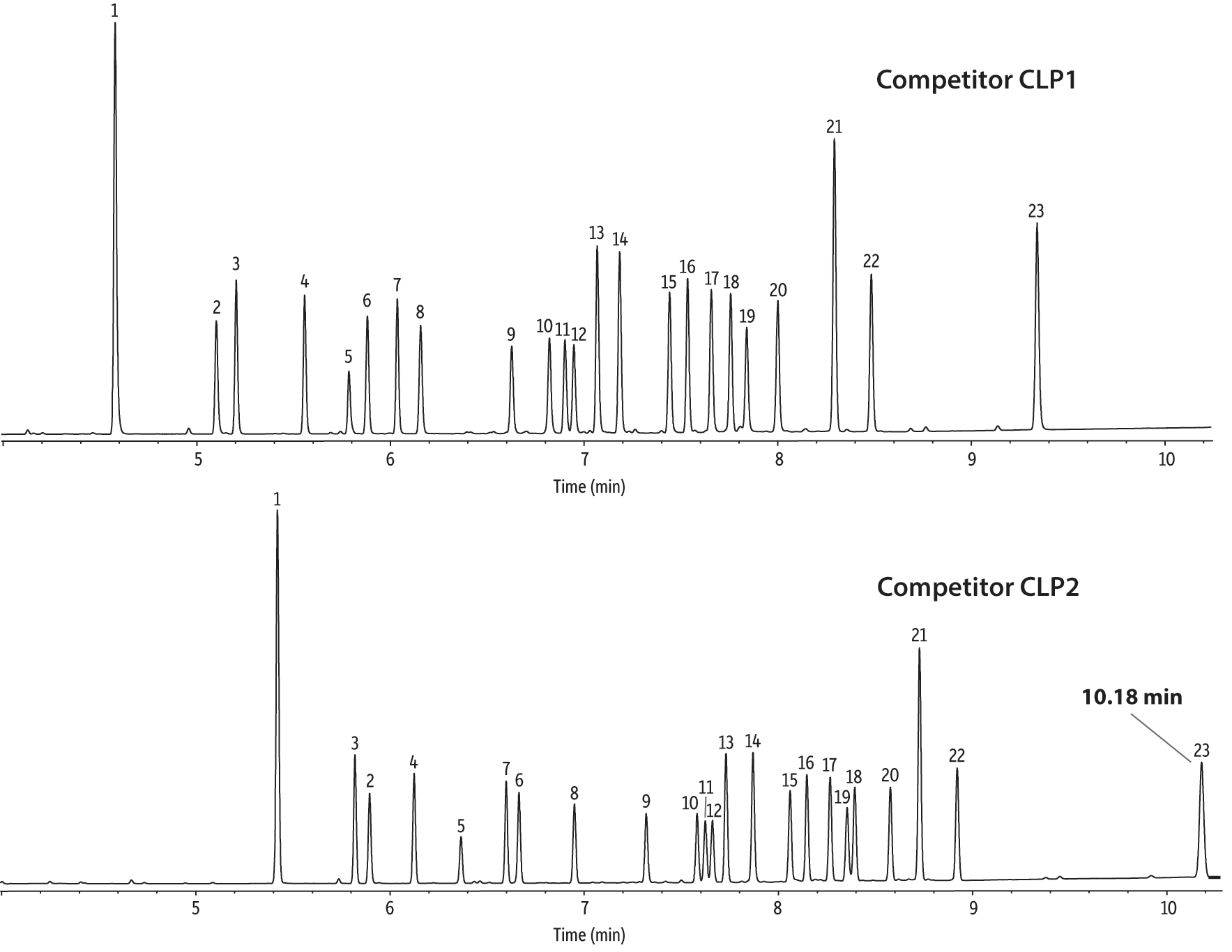
| Peaks | Conc. (ng/mL) | |
|---|---|---|
| 1. | Tetrachloro-m-xylene | 20 |
| 2. | Hexachlorobenzene | 5 |
| 3. | α-BHC | 5 |
| 4. | γ-BHC | 5 |
| 5. | β-BHC | 5 |
| 6. | Heptachlor | 5 |
| 7. | δ-BHC | 5 |
| 8. | Aldrin | 5 |
| 9. | Heptachlor epoxide | 5 |
| 10. | trans-Chlordane | 5 |
| 11. | cis-Chlordane | 5 |
| Peaks | Conc. (ng/mL) | |
|---|---|---|
| 12. | Endosulfan I | 5 |
| 13. | 4,4'-DDE | 10 |
| 14. | Dieldrin | 10 |
| 15. | Endrin | 10 |
| 16. | 4,4'-DDD | 10 |
| 17. | Endosulfan II | 10 |
| 18. | 4,4'-DDT | 10 |
| 19. | Endrin aldehyde | 10 |
| 20. | Endosulfan sulfate | 10 |
| 21. | Methoxychlor | 50 |
| 22. | Endrin ketone | 10 |
| 23. | Decachlorobiphenyl | 20 |
| Columns | Competitor CLP1 30 m, 0.32 mm ID, 0.25 µm, |
|---|---|
| and competitor CLP2 30 m, 0.32 mm ID, 0.5 µm, | |
| using Rxi guard column 5 m, 0.32 mm ID (cat.# 10039) | |
| with universal “Y” Press-Tight connector (cat.# 20406-261) | |
| Standard/Sample | Organochlorine pesticide mix AB #2 (cat.# 32292) |
| 2,4,5,6-Tetrachloro-m-xylene (cat.# 32027) | |
| Decachlorobiphenyl (BZ #209) (cat.# 32029) | |
| Hexachlorobenzene (cat.# 32231) | |
| Diluent: | n-Hexane |
| Injection | |
| Inj. Vol.: | 2 µL splitless (hold 0.75 min) |
| Liner: | Premium 4 mm single taper w/wool (cat.# 23303) |
| Inj. Temp.: | 250 °C |
| Purge Flow: | 50 mL/min |
| Oven | |
| Oven Temp.: | 110 °C (hold 0.5 min) to 325 °C at 25 °C/min (hold 2 min) |
| Carrier Gas | He, constant flow |
| Linear Velocity: | 64 cm/sec |
| Detector | Micro-ECD @ 340 °C |
|---|---|
| Make-up Gas Flow Rate: | 50 mL/min |
| Make-up Gas Type: | N2 |
| Data Rate: | 50 Hz |
| Instrument | Agilent/HP6890 GC |
In addition to providing faster analysis times than the competitor's column set using the standard method, the Rtx-CLPesticides column set can also be operated under an accelerated multi-ramp oven program to obtain sub-7 minute run times (Figure 3). The Rtx-CLPesticides and Rtx-CLPesticides2 columns are finely tuned for organochlorine pesticides and robust enough to maintain resolution after heavy use and aggressive conditions. Column selectivity ensures all compounds are adequately separated for accurate integration, and fast analysis times allow maximum sample throughput when using helium carrier gas. Note that in order to achieve the separation shown here, it may be necessary to use an oven pillow or 220 V instrument, otherwise acceptable resolution may not be obtained because the actual oven temperatures and ramp rates may be lower and slower than the instrument settings. We recommend referring to the published maximum ramping temperatures for your instrument before beginning work. Also, since an oven pillow prevents use of the front inlet, the columns must be hung together on the back hanger with the guard column installed in the back inlet.
For labs currently relying on helium carrier gas, the use of Rtx-CLPesticides columns for organochlorine pesticides analysis is a better alternative than the competitor's CLP column set. All target compounds can be quickly separated with room to spare using a standard method, and sample throughput can be further improved by using an accelerated method that provides good results with fast analysis times of less than 7 minutes.
Figure 3: The unique selectivity of the Rtx-CLPesticides column set allows organochlorine pesticides to be fully resolved in less than 7 min using accelerated oven conditions.
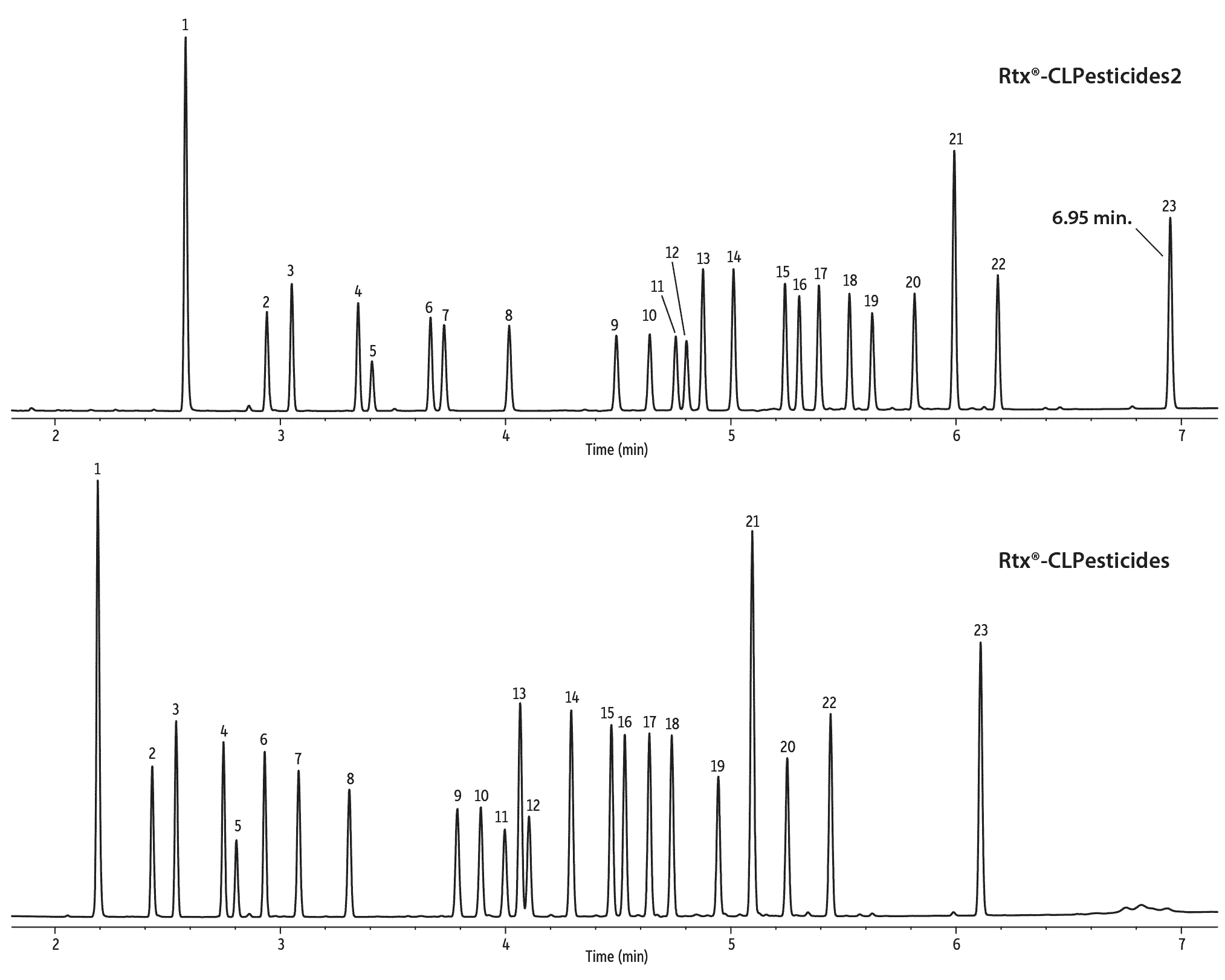
| Peaks | Conc. (ng/mL) | |
|---|---|---|
| 1. | Tetrachloro-m-xylene | 20 |
| 2. | Hexachlorobenzene | 5 |
| 3. | α-BHC | 5 |
| 4. | γ-BHC | 5 |
| 5. | β-BHC | 5 |
| 6. | δ-BHC | 5 |
| 7. | Heptachlor | 5 |
| 8. | Aldrin | 5 |
| 9. | Heptachlor epoxide | 5 |
| 10. | trans-Chlordane | 5 |
| 11. | cis-Chlordane | 5 |
| Peaks | Conc. (ng/mL) | |
|---|---|---|
| 12. | Endosulfan I | 5 |
| 13. | 4,4'-DDE | 10 |
| 14. | Dieldrin | 10 |
| 15. | Endrin | 10 |
| 16. | 4,4'-DDD | 10 |
| 17. | Endosulfan II | 10 |
| 18. | 4,4'-DDT | 10 |
| 19. | Endrin aldehyde | 10 |
| 20. | Endosulfan sulfate | 10 |
| 21. | Methoxychlor | 50 |
| 22. | Endrin ketone | 10 |
| 23. | Decachlorobiphenyl | 20 |
| Columns | Rtx-CLPesticides2 30 m, 0.32 mm ID, 0.25 µm (cat.# 11324) |
|---|---|
| and Rtx-CLPesticides 30 m, 0.32 mm ID, 0.32 µm (cat.# 11141) | |
| using Rxi guard column 5 m, 0.32 mm ID (cat.# 10039) | |
| with universal “Y” Press-Tight connector (cat.# 20406-261) | |
| Standard/Sample | Organochlorine pesticide mix AB #2 (cat.# 32292) |
| Hexachlorobenzene (cat.# 32231) | |
| 2,4,5,6-Tetrachloro-m-xylene (cat.# 32027) | |
| Decachlorobiphenyl (BZ #209) (cat.# 32029) | |
| Diluent: | n-Hexane |
| Injection | |
| Inj. Vol.: | 2 µL splitless (hold 0.3 min) |
| Liner: | Premium 4 mm single taper w/wool (cat.# 23303) |
| Inj. Temp.: | 250 °C |
| Purge Flow: | 50 mL/min |
| Oven | |
| Oven Temp.: | 120 °C to 200 °C at 45 °C/min to 230 °C at 15 °C/min to 330 °C at 30 °C/min (hold 2 min) |
| Carrier Gas | He, constant flow |
| Linear Velocity: | 71 cm/sec |
| Detector | Micro-ECD @ 340 °C |
|---|---|
| Make-up Gas Flow Rate: | 50 mL/min |
| Make-up Gas Type: | N2 |
| Data Rate: | 50 Hz |
| Instrument | Agilent/HP6890 GC |
Option 2: Save Money and Increase Sample Throughput Using Hydrogen Carrier Gas
Hydrogen carrier gas is a popular alternative to helium, because it is the fastest of the three commonly used carrier gases. Its higher optimal linear velocity means faster flow rates can be used, which results in shorter analysis times and increased sample throughput. As shown in Figures 4 and 5, similar separations were obtained on both column sets when using hydrogen carrier gas instead of helium in a shorter analysis time. However, in this case the biggest time savings was attributable to the column set that was used, not to the carrier gas. Once again, over half a minute was saved per analysis when using the Rtx-CLPesticides column set (Figure 4) rather than the competitor's CLP column set (Figure 5).
Figure 4: When using hydrogen carrier gas, organochlorine pesticides elute in 9.36 min with greater resolution of critical pairs on Rtx-CLPesticides columns than with competitor CLP columns.
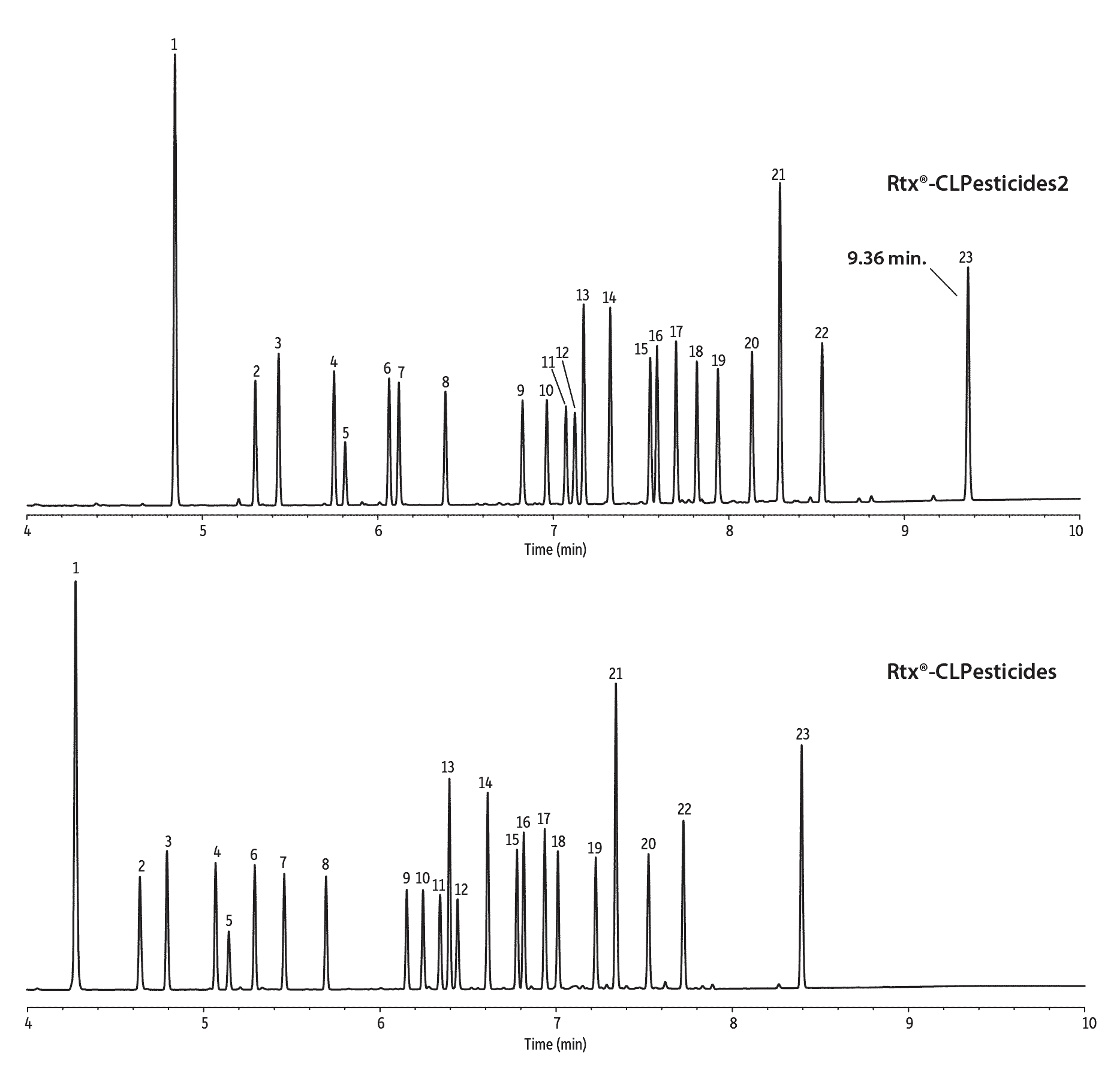
| Peaks | Conc. (ng/mL) | |
|---|---|---|
| 1. | Tetrachloro-m-xylene | 20 |
| 2. | Hexachlorobenzene | 5 |
| 3. | α-BHC | 5 |
| 4. | γ-BHC | 5 |
| 5. | β-BHC | 5 |
| 6. | δ-BHC | 5 |
| 7. | Heptachlor | 5 |
| 8. | Aldrin | 5 |
| 9. | Heptachlor epoxide | 5 |
| 10. | trans-Chlordane | 5 |
| 11. | cis-Chlordane | 5 |
| Peaks | Conc. (ng/mL) | |
|---|---|---|
| 12. | Endosulfan I | 5 |
| 13. | 4,4'-DDE | 10 |
| 14. | Dieldrin | 10 |
| 15. | Endrin | 10 |
| 16. | 4,4'-DDD | 10 |
| 17. | Endosulfan II | 10 |
| 18. | 4,4'-DDT | 10 |
| 19. | Endrin aldehyde | 10 |
| 20. | Endosulfan sulfate | 10 |
| 21. | Methoxychlor | 50 |
| 22. | Endrin ketone | 10 |
| 23. | Decachlorobiphenyl | 20 |
| Columns | Rtx-CLPesticides2 30 m, 0.32 mm ID, 0.25 µm (cat.# 11324) |
|---|---|
| and Rtx-CLPesticides 30 m, 0.32 mm ID, 0.32 µm (cat.# 11141) | |
| using Rxi guard column 5 m, 0.32 mm ID (cat.# 10039) | |
| with universal “Y” Press-Tight connector (cat.# 20406-261) | |
| Standard/Sample | Organochlorine pesticide mix AB #2 (cat.# 32292) |
| 2,4,5,6-Tetrachloro-m-xylene (cat.# 32027) | |
| Decachlorobiphenyl (BZ #209) (cat.# 32029) | |
| Hexachlorobenzene (cat.# 32231) | |
| Diluent: | n-Hexane |
| Injection | |
| Inj. Vol.: | 2 µL splitless (hold 0.75 min) |
| Liner: | Premium 4 mm single taper w/wool (cat.# 23303) |
| Inj. Temp.: | 250 °C |
| Purge Flow: | 50 mL/min |
| Oven | |
| Oven Temp.: | 110 °C (hold 0.5 min) to 325 °C at 25 °C/min (hold 2 min) |
| Carrier Gas | H2, constant flow |
| Linear Velocity: | 52 cm/sec |
| Detector | Micro-ECD @ 340 °C |
|---|---|
| Make-up Gas Flow Rate: | 50 mL/min |
| Make-up Gas Type: | N2 |
| Data Rate: | 50 Hz |
| Instrument | Agilent/HP6890 GC |
Figure 5: Analysis of organochlorine pesticides on the competitor column set using hydrogen carrier gas.

| Peaks | Conc. (ng/mL) | |
|---|---|---|
| 1. | Tetrachloro-m-xylene | 20 |
| 2. | Hexachlorobenzene | 5 |
| 3. | α-BHC | 5 |
| 4. | γ-BHC | 5 |
| 5. | β-BHC | 5 |
| 6. | Heptachlor | 5 |
| 7. | δ-BHC | 5 |
| 8. | Aldrin | 5 |
| 9. | Heptachlor epoxide | 5 |
| 10. | trans-Chlordane | 5 |
| 11. | cis-Chlordane | 5 |
| Peaks | Conc. (ng/mL) | |
|---|---|---|
| 12. | Endosulfan I | 5 |
| 13. | 4,4'-DDE | 10 |
| 14. | Dieldrin | 10 |
| 15. | Endrin | 10 |
| 16. | 4,4'-DDD | 10 |
| 17. | Endosulfan II | 10 |
| 18. | 4,4'-DDT | 10 |
| 19. | Endrin aldehyde | 10 |
| 20. | Endosulfan sulfate | 10 |
| 21. | Methoxychlor | 50 |
| 22. | Endrin ketone | 10 |
| 23. | Decachlorobiphenyl | 20 |
| Columns | Competitor CLP1 30 m, 0.32 mm ID, 0.25 µm, |
|---|---|
| and competitor CLP2 (123-8336) 30 m, 0.32 mm ID, 0.5 µm, | |
| using Rxi guard column 5 m, 0.32 mm ID (cat.# 10039) | |
| with universal “Y” Press-Tight connector (cat.# 20406-261) | |
| Standard/Sample | Organochlorine pesticide mix AB #2 (cat.# 32292) |
| 2,4,5,6-Tetrachloro-m-xylene (cat.# 32027) | |
| Decachlorobiphenyl (BZ #209) (cat.# 32029) | |
| Hexachlorobenzene (cat.# 32231) | |
| Diluent: | n-Hexane |
| Injection | |
| Inj. Vol.: | 2 µL splitless (hold 0.75 min) |
| Liner: | Premium 4 mm single taper w/wool (cat.# 23303) |
| Inj. Temp.: | 250 °C |
| Purge Flow: | 50 mL/min |
| Oven | |
| Oven Temp.: | 110 °C (hold 0.5 min) to 325 °C at 25 °C/min (hold 2 min) |
| Carrier Gas | H2, constant flow |
| Linear Velocity: | 65 cm/sec |
| Detector | Micro-ECD @ 340 °C |
|---|---|
| Make-up Gas Flow Rate: | 50 mL/min |
| Make-up Gas Type: | N2 |
| Data Rate: | 50 Hz |
| Instrument | Agilent/HP6890 GC |
As with the helium carrier gas experiment, the use of an accelerated oven ramp was also explored for analyzing organochlorine pesticides using hydrogen carrier gas and the Rtx-CLPesticides column set. As shown in Figure 6, good separations were obtained for all compounds and the analysis time was further reduced to just 6.75 min. In comparison to the base method used for both column pairs, the results obtained for the Rtx-CLPesticides column set using hydrogen carrier gas and the accelerated multi-ramp oven program provide an opportunity for considerable cost savings and better overall productivity. For labs interested in reducing helium expenditures and maximizing speed and sample throughput, analyzing organochlorine pesticides using hydrogen carrier gas and Rtx-CLPesticides columns with aggressive oven temperature programming is the best alternative.
Figure 6: Sample throughput for organochlorine pesticides can be maximized by using Rtx-CLPesticides columns and hydrogen carrier gas. All peaks elute in just 6.75 min using this inexpensive alternative to helium.
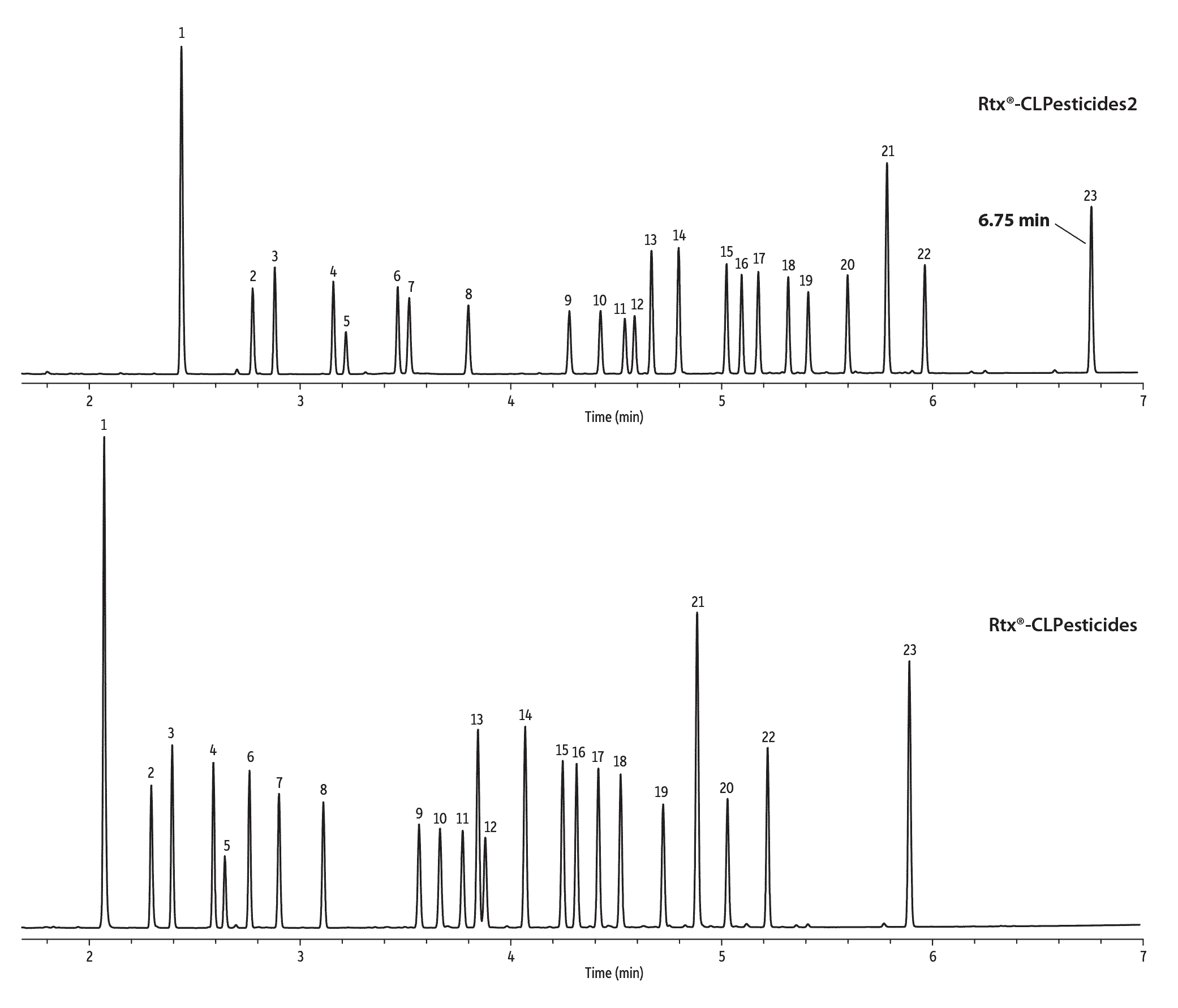
| Peaks | Conc. (ng/mL) | |
|---|---|---|
| 1. | Tetrachloro-m-xylene | 20 |
| 2. | Hexachlorobenzene | 5 |
| 3. | α-BHC | 5 |
| 4. | γ-BHC | 5 |
| 5. | β-BHC | 5 |
| 6. | δ-BHC | 5 |
| 7. | Heptachlor | 5 |
| 8. | Aldrin | 5 |
| 9. | Heptachlor epoxide | 5 |
| 10. | trans-Chlordane | 5 |
| 11. | cis-Chlordane | 5 |
| Peaks | Conc. (ng/mL) | |
|---|---|---|
| 12. | Endosulfan I | 5 |
| 13. | 4,4'-DDE | 10 |
| 14. | Dieldrin | 10 |
| 15. | Endrin | 10 |
| 16. | 4,4'-DDD | 10 |
| 17. | Endosulfan II | 10 |
| 18. | 4,4'-DDT | 10 |
| 19. | Endrin aldehyde | 10 |
| 20. | Endosulfan sulfate | 10 |
| 21. | Methoxychlor | 50 |
| 22. | Endrin ketone | 10 |
| 23. | Decachlorobiphenyl | 20 |
| Columns | Rtx-CLPesticides2 30 m, 0.32 mm ID, 0.25 µm (cat.# 11324) |
|---|---|
| and Rtx-CLPesticides 30 m, 0.32 mm ID, 0.32 µm (cat.# 11141) | |
| using Rxi guard column 5 m, 0.32 mm ID (cat.# 10039) | |
| with universal “Y” Press-Tight connector (cat.# 20406-261) | |
| Standard/Sample | Organochlorine pesticide mix AB #2 (cat.# 32292) |
| 2,4,5,6-Tetrachloro-m-xylene (cat.# 32027) | |
| Decachlorobiphenyl (BZ #209) (cat.# 32029) | |
| Hexachlorobenzene (cat.# 32231) | |
| Diluent: | n-Hexane |
| Injection | |
| Inj. Vol.: | 2 µL splitless (hold 0.3 min) |
| Liner: | Premium 4 mm single taper w/wool (cat.# 23303) |
| Inj. Temp.: | 250 °C |
| Purge Flow: | 50 mL/min |
| Oven | |
| Oven Temp.: | 120 °C to 200 °C at 45 °C/min to 230 °C at 15 °C/min to 330 °C at 30 °C/min (hold 2 min) |
| Carrier Gas | H2, constant flow |
| Linear Velocity: | 81 cm/sec |
| Detector | Micro-ECD @ 340 °C |
|---|---|
| Make-up Gas Flow Rate: | 50 mL/min |
| Make-up Gas Type: | N2 |
| Data Rate: | 50 Hz |
| Instrument | Agilent/HP6890 GC |
Often, the first concern when considering switching to hydrogen carrier gas is understanding and managing the safety issues. Fortunately hydrogen generators minimize much of the risk. Hydrogen generators produce hydrogen gas on demand, so much smaller quantities are stored compared to high-pressure gas cylinders. In addition, generators use controlled flow rates, built-in sensors, and automatic shut-off features that turn the unit off in the event a leak is detected. With these safety features engineered into the unit, hydrogen generators reduce much of the risk associated with using hydrogen carrier gas.
Another issue with using hydrogen that receives less attention than safety concerns is the potential for chemical reactions that contribute to system activity. During the work described here, we observed a decrease in peak response for several compounds when hydrogen was used instead of helium. This decreased response is indicative of activity problems in the inlet and was most pronounced for methoxychlor and 4,4'-DDT (Figure 7). System activity can be caused by metal shavings in the liner catalyzing a hydrogenation reaction between the hydrogen carrier gas and the pesticides. Since metal shavings are generated by the needle scraping a metal needle guide, using a Merlin Microseal septum and a 23 g needle will eliminate this problem and is recommended especially when using hydrogen carrier gas. Merlin Microseal septa are made from a wear-resistant fluorocarbon elastomer. The elastomer construction of the Merlin Microseal, in combination with its unique two-stage sealing mechanism and rounded needle, greatly reduces the generation of metal particles in the liner. Review our technical blog for more on reducing analyte breakdown by using Merlin Microseal septum.
Figure 7: When using hydrogen carrier gas, peak response can be reduced for active compounds unless a Merlin Microseal septum is used.
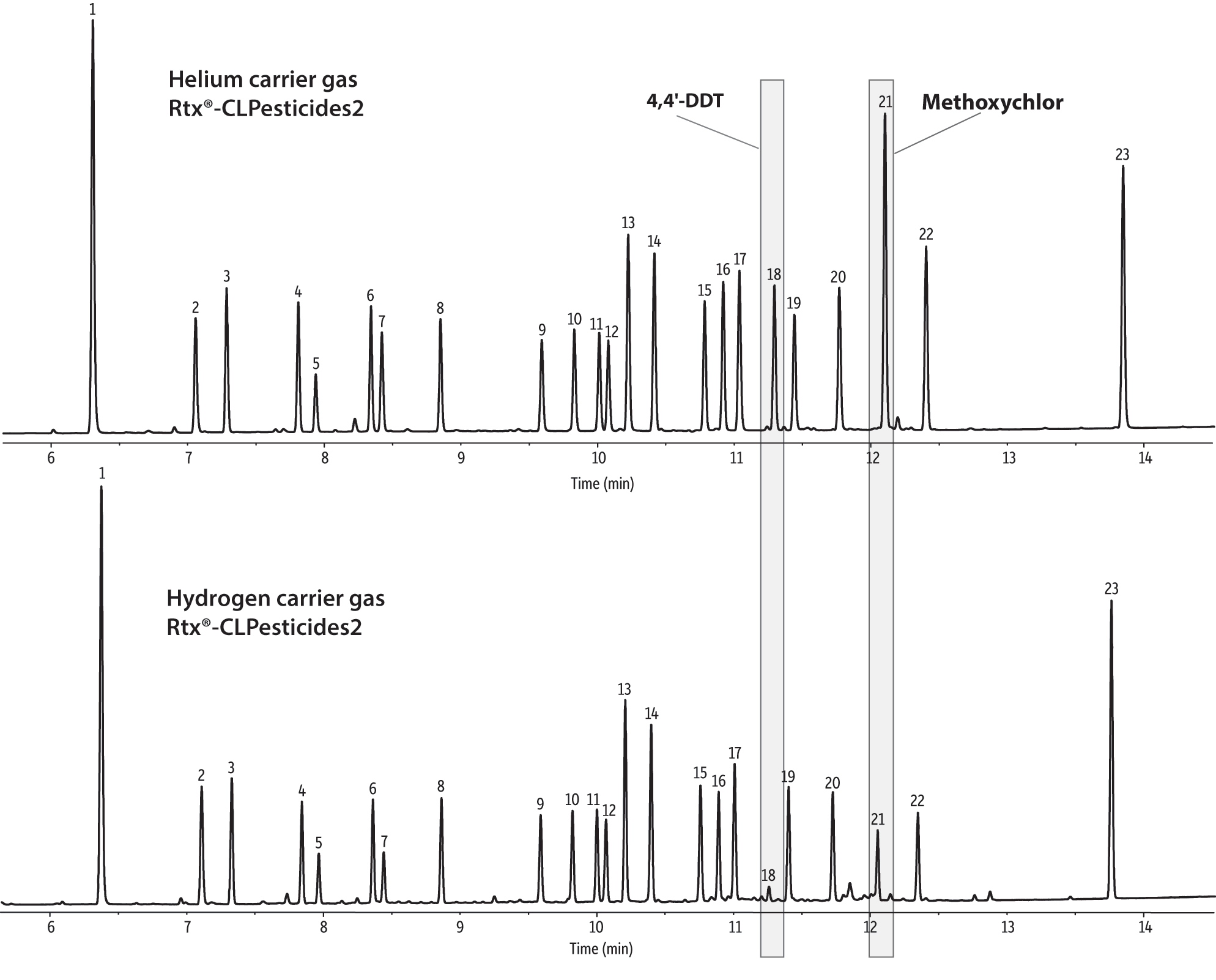
| Peaks | Conc. (ng/mL) | |
|---|---|---|
| 1. | Tetrachloro-m-xylene | 20 |
| 2. | Hexachlorobenzene | 5 |
| 3. | α-BHC | 5 |
| 4. | γ-BHC | 5 |
| 5. | β-BHC | 5 |
| 6. | δ-BHC | 5 |
| 7. | Heptachlor | 5 |
| 8. | Aldrin | 5 |
| 9. | Heptachlor epoxide | 5 |
| 10. | trans-Chlordane | 5 |
| 11. | cis-Chlordane | 5 |
| Peaks | Conc. (ng/mL) | |
|---|---|---|
| 12. | Endosulfan I | 5 |
| 13. | 4,4'-DDE | 10 |
| 14. | Dieldrin | 10 |
| 15. | Endrin | 10 |
| 16. | 4,4'-DDD | 10 |
| 17. | Endosulfan II | 10 |
| 18. | 4,4'-DDT | 10 |
| 19. | Endrin aldehyde | 10 |
| 20. | Endosulfan sulfate | 10 |
| 21. | Methoxychlor | 50 |
| 22. | Endrin ketone | 10 |
| 23. | Decachlorobiphenyl | 20 |
| Columns | Rtx-CLPesticides2 30 m, 0.32 mm ID, 0.25 µm (cat.# 11324) |
|---|---|
| and Rtx-CLPesticides 30 m, 0.32 mm ID, 0.32 µm (cat.# 11141) | |
| using Rxi guard column 5 m, 0.32 mm ID (cat.# 10039) | |
| with universal “Y” Press-Tight connector (cat.# 20406-261) | |
| Standard/Sample | Organochlorine pesticide mix AB #2 (cat.# 32292) |
| Hexachlorobenzene (cat.# 32231) | |
| 2,4,5,6-Tetrachloro-m-xylene (cat.# 32027) | |
| Decachlorobiphenyl (BZ #209) (cat.# 32029) | |
| Diluent: | n-Hexane |
| Injection | |
| Inj. Vol.: | 2 µL splitless (hold 0.75 min) |
| Liner: | Premium 4 mm single taper w/wool (cat.# 23303) |
| Inj. Temp.: | 250 °C |
| Purge Flow: | 50 mL/min |
| Oven | |
| Oven Temp.: | 110 °C (hold 0.5 min) to 325 °C at 25 °C/min (hold 2 min) |
| Carrier Gas | He, constant flow |
| Linear Velocity: | 52 cm/sec |
| Detector | Micro-ECD @ 340 °C |
|---|---|
| Make-up Gas Flow Rate: | 50 mL/min |
| Make-up Gas Type: | N2 |
| Data Rate: | 50 Hz |
| Instrument | Agilent/HP6890 GC |
| Notes | Conditions above are for helium carrier gas. For hydrogen carrier gas conditions, see chromatogram GC_EV1327. |
Option 3: Simplify the Gas System and Reduce Costs Using Nitrogen
Nitrogen carrier gas is also a viable option for analyzing organochlorine pesticides using GC-ECD. Assuming it is also used as the ECD makeup gas, nitrogen allows for a much simpler and less expensive setup since it is less expensive than helium and because only one source of gas is needed to operate the instrument. The tradeoff with nitrogen is that it is a slower carrier gas, so its use is limited to situations where longer analysis times are acceptable.
The unique selectivities of the Rtx-CLPesticides and Rtx-CLPesticides2 columns make the use of nitrogen carrier gas feasible and provide reasonable analysis times. Figure 8 demonstrates that, while peaks are somewhat broader than when using helium or hydrogen, adequate resolution is obtained for all organochlorine pesticides on the Rtx-CLPesticides column set. The optimized selectivity of this column pair provides enough resolution between peaks to accommodate analysis outside optimum flow conditions. This allows easy transferability of helium-based methods to alternate carrier gases. In addition, the last compound elutes at 9.37 min, which is comparable to results obtained when using the basic single ramp method with either helium or hydrogen. In contrast, regardless of the flow rate used, adequate resolution could not be obtained on the competitor's CLP column for cis- and trans-chlordane as well as for endosulfan I (Figure 9). If using nitrogen carrier gas is desired as a way to reduce helium consumption and related costs, Rtx-CLPesticides columns are the only viable option.
Figure 8: Only Rtx-CLPesticides and Rtx-CLPesticides2 columns provide adequate resolution when using nitrogen carrier gas, allowing labs to take advantage of this inexpensive alternative to helium carrier gas.
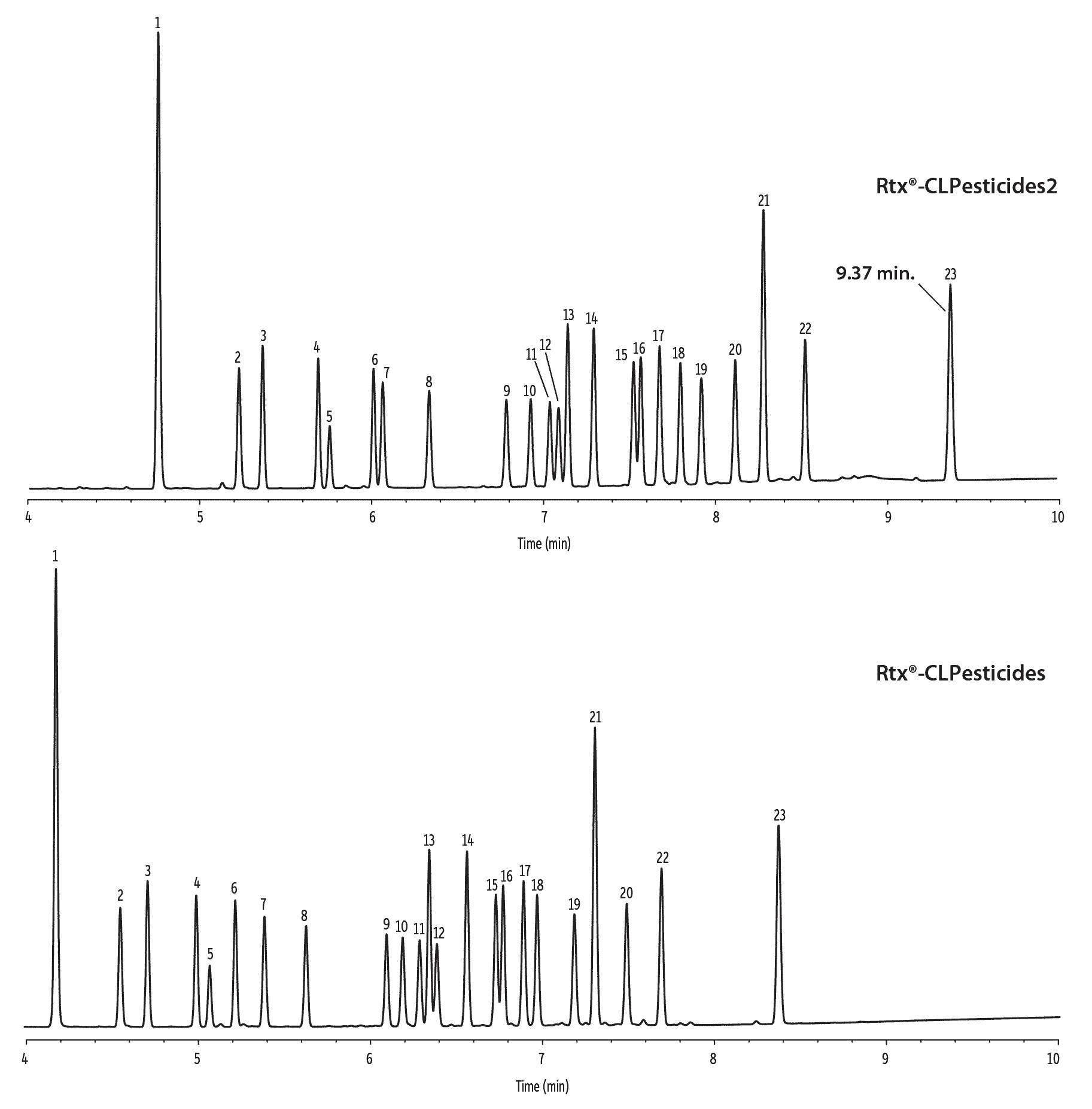
| Peaks | Conc. (ng/mL) | |
|---|---|---|
| 1. | Tetrachloro-m-xylene | 20 |
| 2. | Hexachlorobenzene | 5 |
| 3. | α-BHC | 5 |
| 4. | γ-BHC | 5 |
| 5. | β-BHC | 5 |
| 6. | δ-BHC | 5 |
| 7. | Heptachlor | 5 |
| 8. | Aldrin | 5 |
| 9. | Heptachlor epoxide | 5 |
| 10. | trans-Chlordane | 5 |
| 11. | cis-Chlordane | 5 |
| Peaks | Conc. (ng/mL) | |
|---|---|---|
| 12. | Endosulfan I | 5 |
| 13. | 4,4'-DDE | 10 |
| 14. | Dieldrin | 10 |
| 15. | Endrin | 10 |
| 16. | 4,4'-DDD | 10 |
| 17. | Endosulfan II | 10 |
| 18. | 4,4'-DDT | 10 |
| 19. | Endrin aldehyde | 10 |
| 20. | Endosulfan sulfate | 10 |
| 21. | Methoxychlor | 50 |
| 22. | Endrin ketone | 10 |
| 23. | Decachlorobiphenyl | 20 |
| Columns | Rtx-CLPesticides2 30 m, 0.32 mm ID, 0.25 µm (cat.# 11324) |
|---|---|
| and Rtx-CLPesticides 30 m, 0.32 mm ID, 0.32 µm (cat.# 11141) | |
| using Rxi guard column 5 m, 0.32 mm ID (cat.# 10039) | |
| with universal “Y” Press-Tight connector (cat.# 20406-261) | |
| Standard/Sample | Organochlorine pesticide mix AB #2 (cat.# 32292) |
| 2,4,5,6-Tetrachloro-m-xylene (cat.# 32027) | |
| Decachlorobiphenyl (BZ #209) (cat.# 32029) | |
| Hexachlorobenzene (cat.# 32231) | |
| Diluent: | n-Hexane |
| Injection | |
| Inj. Vol.: | 2 µL splitless (hold 0.75 min) |
| Liner: | Premium 4 mm single taper w/wool (cat.# 23303) |
| Inj. Temp.: | 250 °C |
| Purge Flow: | 50 mL/min |
| Oven | |
| Oven Temp.: | 110 °C (hold 0.5 min) to 325 °C at 25 °C/min (hold 2 min) |
| Carrier Gas | N2, constant flow |
| Linear Velocity: | 53 cm/sec |
| Detector | Micro-ECD @ 340 °C |
|---|---|
| Make-up Gas Flow Rate: | 50 mL/min |
| Make-up Gas Type: | N2 |
| Data Rate: | 50 Hz |
| Instrument | Agilent/HP6890 GC |
Figure 9: Nitrogen carrier gas is not a viable option when using the competitor's CLP column set as resolution is inadequate between critical organochlorine pesticides.
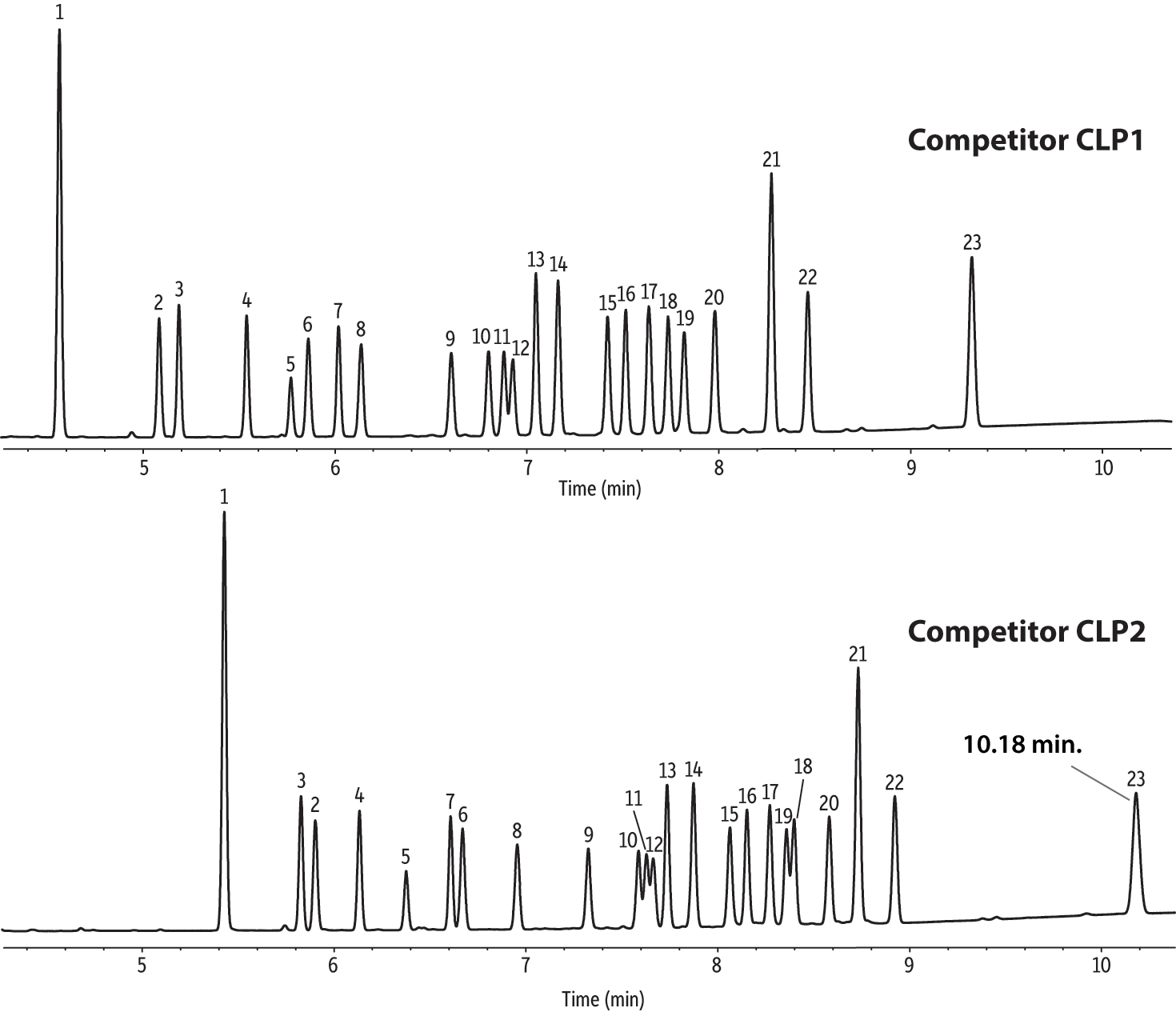
| Peaks | Conc. (ng/mL) | |
|---|---|---|
| 1. | Tetrachloro-m-xylene | 20 |
| 2. | Hexachlorobenzene | 5 |
| 3. | α-BHC | 5 |
| 4. | γ-BHC | 5 |
| 5. | β-BHC | 5 |
| 6. | Heptachlor | 5 |
| 7. | δ-BHC | 5 |
| 8. | Aldrin | 5 |
| 9. | Heptachlor epoxide | 5 |
| 10. | trans-Chlordane | 5 |
| 11. | cis-Chlordane | 5 |
| Peaks | Conc. (ng/mL) | |
|---|---|---|
| 12. | Endosulfan I | 5 |
| 13. | 4,4'-DDE | 10 |
| 14. | Dieldrin | 10 |
| 15. | Endrin | 10 |
| 16. | 4,4'-DDD | 10 |
| 17. | Endosulfan II | 10 |
| 18. | 4,4'-DDT | 10 |
| 19. | Endrin aldehyde | 10 |
| 20. | Endosulfan sulfate | 10 |
| 21. | Methoxychlor | 50 |
| 22. | Endrin ketone | 10 |
| 23. | Decachlorobiphenyl | 20 |
| Columns | Competitor CLP1 30 m, 0.32 mm ID, 0.25 µm, |
|---|---|
| and competitor CLP2 30 m, 0.32 mm ID, 0.5 µm, | |
| using Rxi guard column 5 m, 0.32 mm ID (cat.# 10039) | |
| with universal “Y” Press-Tight connector (cat.# 20406-261) | |
| Standard/Sample | Organochlorine pesticide mix AB #2 (cat.# 32292) |
| 2,4,5,6-Tetrachloro-m-xylene (cat.# 32027) | |
| Decachlorobiphenyl (BZ #209) (cat.# 32029) | |
| Hexachlorobenzene (cat.# 32231) | |
| Diluent: | n-Hexane |
| Injection | |
| Inj. Vol.: | 2 µL splitless (hold 0.75 min) |
| Liner: | Premium 4 mm single taper w/wool (cat.# 23303) |
| Inj. Temp.: | 250 °C |
| Purge Flow: | 50 mL/min |
| Oven | |
| Oven Temp.: | 110 °C (hold 0.5 min) to 325 °C at 25 °C/min (hold 2 min) |
| Carrier Gas | N2, constant flow |
| Linear Velocity: | 64 cm/sec |
| Detector | Micro-ECD @ 340 °C |
|---|---|
| Make-up Gas Flow Rate: | 50 mL/min |
| Make-up Gas Type: | N2 |
| Data Rate: | 50 Hz |
| Instrument | Agilent/HP6890 GC |
Conclusion
As labs explore the use of alternate carrier gases as a way to reduce dependence on helium, using Rtx-CLPesticides and Rtx-CLPesticides2 columns is the most advantageous strategy. These columns are tuned specifically to provide optimal selectivity for organochlorine pesticides when analyzed using electron capture detection, ensuring that they reliably produce good separations in less time than comparable competitor CLP columns. Not only do the Rtx-CLPesticides columns produce faster results under traditional operating conditions, they can also be operated under accelerated ramps and flow rates to produce sub-7 minute analyses with both helium and hydrogen. In addition, they are the only column set that makes the use of nitrogen carrier gas a practical option, which gives you the freedom to choose the carrier gas option that best meets your needs.

